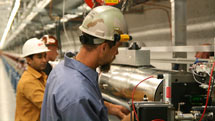
Handy Links
SLAC News Center
SLAC Today
- Subscribe
- Archives: Feb 2006-May 20, 2011
- Archives: May 23, 2011 and later
- Submit Feedback or Story Ideas
- About SLAC Today
SLAC News
Lab News
- Interactions
- Lightsources.org
- ILC NewsLine
- Int'l Science Grid This Week
- Fermilab Today
- Berkeley Lab News
- @brookhaven TODAY
- DOE Pulse
- CERN Courier
- DESY inForm
- US / LHC
SLAC Links
- Emergency
- Safety
- Policy Repository
- Site Entry Form

- Site Maps
- M & O Review
- Computing Status & Calendar
- SLAC Colloquium
- SLACspeak
- SLACspace
- SLAC Logo
- Café Menu
- Flea Market
- Web E-mail
- Marguerite Shuttle
- Discount Commuter Passes
-
Award Reporting Form
- SPIRES
- SciDoc
- Activity Groups
- Library
Stanford
Around the Bay
LCLS Team Installs Final Undulator
The Linac Coherent Light Source put a punctuation mark on recent progress Wednesday, July 22, as staff from SLAC's Mechanical Fabrication Department installed the last of the 33 undulator magnets that will be used to drive the LCLS X-ray beamline. Team members scribbled their signatures on the undulator shells to mark the occasion, the row of magnets stretching 433 feet along the length of the Undulator Hall. The milestone highlights substantial progress this summer, which also saw the introduction of new diagnostic equipment and first X-rays into the Front End Enclosure.
The undulators were created at Argonne National Laboratory, then tuned at SLAC's Magnetic Measurement Facility, where a collaborative team of MMF physicists, engineers and technicians spent the last two years processing all 33 of the devices. To get the undulators ready, the MMF team had to calibrate and align each unit's 224 magnets, then do something called fiducializing—a process that ensures all of the undulators are aligned with one another once installed. According to Eric Lundahl, coordinator for MMF undulator and girder Coordinate Measurement Machine measurements, each device took about two weeks to get ready.
"It's a lot of work," Lundahl said. "They're extraordinarily sensitive instruments."
But even with all of the units in place, maintaining the undulators will be an ongoing project. Because radiation degrades magnetic fields, each device will have to be recalibrated every three months. This means that they will have to be shuffled around regularly as different units are taken back to MMF for recalibration.
The undulators are crucial components for the LCLS. The array of magnets causes electron bunches from the linac to wiggle back and forth on their path coming from SLAC's linear accelerator. This movement causes the emission of X-rays, which can then be used to study the properties of matter from biological molecules to novel superconducting materials.
Before the beam can be used to do science, though, it has to travel through the Front End Enclosure, where a suite of instruments will perform diagnostics on the beam and direct the X-rays toward the Near and Far Experimental Halls. The LCLS team finished installing the components that will analyze the beam's intensity in June, and brought the first X-rays into the FEE on June 30. Commissioning of the devices is ongoing. Meanwhile, work has started on the installation of the optical mirrors that will manipulate the beam and send it to the different scientific instruments. With the goal to be ready for first scientific experiments this fall, the LCLS team has busy months ahead.
"There is a great deal of effort being put into the control system for all of this hardware," said FEE Manager Hal Tompkins. "The system is by no means complete. It's a work in progress and a lot more needs to be done."
—Nicholas Bock
SLAC Today, July 23, 2009
